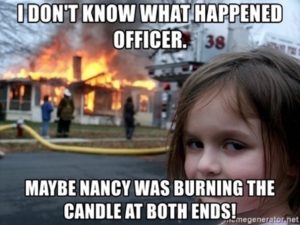Are you working day and night on a project? You could say you're 'burning the candle at both ends.' This post unpacks the meaning and origin of this expression.
Meaning
The expression 'burning the candle at both ends' means someone is working hard day and night, taking little rest. They could be working on research, a project, or just dealing with a hectic life where they have severe constraints on their time.
People that 'burn the candle at both ends' are top performers in their industry. However, the phrase can also refer to home life. For instance, a single mother with a day job is 'burning the candle at both ends' to take care of her kids and put food on the table.
Example Usage
"I'm worried about Kim. She's burning the candle at both ends lately, and I think she might burn out from the stress."
"We've been working on the project day and night, burning the candle at both ends. It's been a Herculean effort, but we'll have the project ready by the deadline."
"There's no point burning the candle at both ends for no reward. This company expects us to work around the clock, but they don't pay us for our labor."
"We were burning the candle at both ends for too long. Now the teams feel burned out and need a break to recover."
"My doctor told me I must stop burning the candle at both ends or I might have a stroke. I better take his advice and slow things down."
"If you're burning the candle at both ends, you will hit the wall sooner or later. It's better to take a slow and steady approach to things."
"The top academics in the industry are burning the candle at both ends. Look at any office park; the lights on at 3 am are the Nobel prize winners."


Origin
The expression 'burning the candle at both ends' originates from the French language.
The phrase's first appearance appears in Randal Cotgrave's Dictionary in 1611. The phrase's original meaning referred to reckless spending resulting in diminishing wealth.
Candles we expensive items in the 1600s, and while burning a candle at both ends brings more light into the room, it's also wasteful. The idiom changes its meaning in the early 1900s to the current version we use today.
Edna St. Vincent Millay used the idiom in its current form in 1918 in her poem "Figs from Thistles: First Fig." The saying appears as follows.
"My candle burns at both ends; It will not last the night; But ah, my foes, and oh, my friends – It gives a lovely light."
Phrases Similar to Burning the Candle at both Ends
- Pushing hard.
- Spread oneself too thin.
- Bite-off-more-than-one-can-chew.
- Keep your nose to the grindstone.
- Stay on the treadmill.
- Burning the midnight oil.
Phrases Opposite to Burning the Candle at Both Ends
- Taking it easy.
- Minimal effort.
- Lazy.
What is the Correct Saying?
- Burning the candle at both ends.
- Burn the candle at both ends.
Ways People May Say Burning the Candle at Both Ends Incorrectly
The phrase 'burning the candle at both ends doesn't refer to burning a candle. It means that someone is working harder than normal and is at risk of burning themselves out. Using the phrase to describe candles or lighting is incorrect.
Acceptable Ways to Phrase Burning the Candle at Both Ends
You can use the expression 'burning the candle at both ends' to describe social and professional situations involving someone working hard at something. For instance, you could say the boss has been burning the candle at both ends and sleeping in the office to keep the company running.
Or, you could say your partner has been burning the candle at both ends by studying at night and looking after the kids. The phrase suits text-based communications and verbal exchanges. Typically, you'll use it to describe someone working hard close to experiencing burnout.